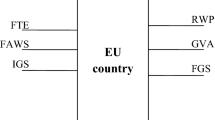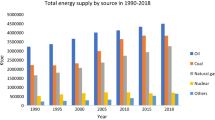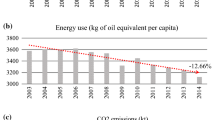Abstract
This paper applies the modified undesirable dynamic data envelopment analysis (DEA) model by considering the role of forest carbon sinks to evaluate European countries’ carbon dioxide (CO2) emissions and productivity efficiency. Taking population and energy consumption as input variables, gross domestic product (GDP) as the desirable input, CO2 as the undesirable output, and fixed assets as an inter-temporal carry-out input variable, our results suggest considering the fixed amount of the forest carbon sinks significantly affects efficiency rankings. The overall efficiency rankings for Ireland, Austria, Italy, Germany, Spain, and Belgium look to be overrated, while those of Finland, France, and Netherlands are apparently underrated. In terms of Total-Factor Efficiency analysis, countries with the best performance in efficiency ranking are Denmark, Luxembourg, Norway, Sweden, and the UK, thanks to their long-term effort at addressing the impact of forest carbon sinks and the effect of CO2 emissions on efficiency.

Similar content being viewed by others
Data availability
There is no availability of data and materials.
Notes
Carbon sinks refer to processes, activities, or mechanisms capable of removing carbon dioxide from the atmosphere.
References
Akbari H (2002) Shade trees reduce building energy use and CO2 emissions from power plants. Environ Pollut 116:119–126
Apergis N, Aye GC, Barros CP, Gupta R, Wanke P (2015) Energy efficiency of selected OECD countries: A slacks based model with undesirable outputs. Energy Econ 51:45–53
Bian YW, He P, Xu H (2013) Estimation of potential energy saving and carbon dioxide emission reduction in China based on an extended non-radial DEA approach. Energy Policy 63:962–971
Banker RD, Charnes A, Cooper WW (1984) Some models for estimating technical and scale inefficiencies in data envelopment analysis. Manage Sci 30(9):1078–1092
Bogetoft, P., Christensen, D. L., Damgard, I., Geisler, M., Jakobsen,T.P., Krøigaard,M., Nielsen,J.D., Nielsen,J.B., Nielsen,K., Pagter,J., Schwartzbach, M. I., Toft, T. (2008). Multiparty Computation Goes Live. Financial Cryptography and Data Security. Springer Berlin Heidelberg: 325–343.
Chang MC (2014) Energy intensity, target level of energy intensity, and room for improvement in energy intensity: An application to the study of regions in the EU. Energy Policy 67:648–655
Chen, Y., Liu, B., Shen, Y., & Wang, X. (2015). The energy efficiency of China's regional construction industry based on the three-stage DEA model and the DEA-DA model. KSCE J Civ Eng,1–14.
Chen CM (2009) A network-DEA model with new efficiency measures to incorporate the dynamic effect in production networks. Eur J Oper Res 194(3):687–699
Choi Y, Zhang N, Zhou P (2012) Efficiency and abatement costs of energy-related CO2 emissions in China: A slacks-based efficiency measure. Appl Energy 98:198–208
Charnes A, Cooper WW, Rhodes E (1978) Measuring the efficiency of decision-making units. Eur J Oper Res 2(6):429–444
Cui Q, Kuang HB, Wu CY, Li Y (2014) The changing trend and influencing factors of energy efficiency: the case of nine countries. Energy 64:1026–1034
Duan N, Guo JP, Xie BC (2016) Is there a difference between the energy and CO2 emission performance for China’s thermal power industry? A bootstrapped directional distance function approach. Appl Energy 162:1552–1563
Dyckhoff H, Allen K (2001) Measuring ecological efficiency with data envelopment analysis (DEA). Eur J Oper Res 132(2):312–325
Emrouznejad A, Yang GL (2016) CO2 emissions reduction of Chinese light manufacturing industries: A novel RAM-based global Malmquist-Luenberger productivity index. Energy Policy 96:397–410
FAO, F. (2018). The State of the World’s Forests 2018 - Forest pathways to sustainable development. Rome.
Fan M, Shao S, Yang L (2015) Combining global Malmquist-Luenberger index and generalized method of moments to investigate industrial total factor CO2 emission performance: a case of Shanghai (China). Energy Policy 79:189–201
Farrell MJ (1957) The measurement of productive efficiency. Journal of the Royal Statistical Society: Series A (general) 120(3):253–281
Färe R, Grosskopf S, Norris M, Zhang Z (1994) Productivity growth, technical progress, and efficiency change in industrialized countries. Am Econ Rev 84(1):66–83
Färe R, Grosskopf S (1996) Productivity and intermediate products: A frontier approach. Econ Lett 50(1):65–70
FAO (2015) Global Forest Resources Assessment 2015: How have the world’s forests changed? Italy, Rome
Fischlin, A., G.F. Midgley, J. Price, R. Leemans, B. Gopal, C. Turley, M. Rounsevell, P. Dube, J. Tarazona, A. Velichko (2007): Ecosystems, their properties, goods, and services, Chapter 4 in: Climate Change 2007: Climate Change Impacts, Adaptation and Vulnerability, The IPCC Fourth Assessment Report, Cambridge University Press, Cambridge
Guo XD, Zhu L, Fan Y, Xie BC (2011) Evaluation of potential reductions in carbon emissions in Chinese provinces based on environmental DEA. Energy Policy 39(5):2352–2360
Guo, L.L., Wu, C., Qu, Y., & Yu, J.T. (2015). Evaluation of the energy-saving and emission reduction potential for Chinese provinces based on regional difference coefficients. J Renew Sustain Energy 7(4), 043149
Lansink AO, Reinhard S (2004) Investigating technical efficiency and potential technological change in Dutch pig fanning. Agric Syst 79(3):353–367
Lee M (2011) Potential cost savings from internal/external CO2 emissions trading in the Korean electric power industry. Energy Policy 39(10):6162–6167
Lin B, Fei R (2015) Regional differences of CO2 emissions performance in China’s agricultural sector: A Malmquist index approach. Eur J Agron 70:33–40
Li Y, Sun L, Feng T, Zhu C (2013) How to reduce energy intensity in China: A regional comparison perspective. Energy Policy 61:513–522
Li K, Lin B (2015) Metafroniter energy efficiency with CO2 emissions and its convergence analysis for China. Energy Economics 48:230–241
Löwe H, Seufert G, Raes F (2000) Comparison of methods used within Member States for estimating CO2 emissions and sink according to UNFCCC and EU monitoring mechanism: forest and other wooded land. Biotechnol Agron Soc Environ 4(4):315–319
Hailu A, Veeman TS (2001) Non-parametric productivity analysis with undesirable outputs: an application to Canadian pulp and paper industry. Am J Agr Econ 83(3):605–616
Hu JL, Wang SC (2006) Total factor energy efficiency of regions in China. Energy Policy 34(17):3206–3217
Intergovernmental Panel on Climate Change (IPCC) (2003). Good practice guidance for land use, land-use change and forestry. Penman, J., Gytarsky, M., Hiraishi, T., Krug, T., Kruger, D., Pipatti, R., Buendia, L., Miwa, K., Ngara, T., Tanabe, K. and Wagner, F., Eds., Institute for Global Environmental Strategies (IGES), Kanagawa
Karjalainen, T., & Mäkipää, R. (2000). Contribution of forests and forestry in Finland to mitigate greenhouse effect. Biotechnol Agronomy, Soc Environ (BASE), 4(4), 275–280.
Klopp, G. A. (1985). The analysis of the efficiency of production system with multiple inputs and outputs. Ph.D. dissertation, Industrial and Systems Engineering, University of Illinois, Chicago, IL
Maclaren J (2000) Trees in the Greenhouse: The Role of Forestry in Mitigating the Enhanced Greenhouse Effect. New Zealand Forest Research Institute Ltd., Rotorua, New Zealand
Matsushita K, Yamane F (2012) Pollution from the electric power sector in Japan and efficient pollution reduction. Energy Economics 34(4):1124–1130
Mallikarjun S, Lewis HF (2014) Energy technology allocation for distributed energy resources: a strategic technology-policy framework. Energy 72:783–799
Malmquist S (1953) Index numbers and indifference surfaces. Trabajos De Estadistica y De Investigacion Operativa 4(2):209–242
Martínez CIP (2011) Energy efficiency development in German and Colombian non-energy-intensive sectors: a non-parametric analysis. Energ Effi 4(1):115–131
Nowak DJ, Crane DE (2002) Carbon storage and sequestration by urban trees in the USA. Environ Pollut 116:381–389
Organisation for Economic Co-Operation, & Statistical Office of the European Communities. (1997). Oslo Manual: proposed guidelines for collecting and interpreting technological innovation data. OECD Publishing.
Peyrache-Gadeau V (2007) Natural resources, innovative milieux and the environmentally sustainable development of regions. Eur Plan Stud 15(7):945–959
Pang RZ, Deng ZQ, Hu JL (2015) Clean energy use and total-factor efficiencies: An international comparison. Renew Sustain Energy Rev 52:1158–1171
Park H, Lim J (2009) Valuation of marginal CO2 abatement options for electric power plants in Korea. Energy Policy 37(5):1834–1841
Park KS, Park K (2009) Measurement of multiperiod aggregative efficiency. Eur J Oper Res 193(2):567–580
Rowntree RA, Nowak DJ (1991) Quantifying the role of urban forests in removing atmospheric carbon dioxide. J Arboric 17(10):269–275
Sedjo RA (1989) Forests to offset the greenhouse effect. J Forest 87(7):12–15
Song M-L, Zhang L-L, Liu W, Fisher R (2013) Bootstrap-DEA analysis of BRICS’ energy efficiency based on small sample data. Appl Energy 112:1049–1055
Tone KA (2001) Slacks-based measure of efficiency in data envelopment analysis. Eur J Oper Res 130(3):498–509
Tone K, Tsutsui M (2010) Dynamic DEA: A slacks-based measure approach. Omega 38(3–4):145–156
Tsiapa M, Kallioras D, Tzeremes NG (2018) The role of path-dependence in the resilience of EU regions. Eur Plan Stud 26(6):1099–1120
Wang K, Wei YM (2014) China’s regional industrial energy efficiency and carbon emissions abatement costs. Appl Energy 130:617–631
Wang Q, Chiu YH, Chiu CR (2017) Non-radial meta-frontier approach to identify carbon emission performance and intensity. Renew Sustain Energy Rev 69:664–672
Wu AH, Cao YY, Liu B (2014) Energy efficiency evaluation for regions in China: an application of DEA and Malmquist indices. Energ Effi 7(3):429–439
Woodbury PB, Smith JE, Heath LS (2007) Carbon sequestration in the US forest sector from 1990 to 2010. For Ecol Manage 241(1):14–27
Yeh TL, Chen TY, Lai PY (2010) A comparative study of energy utilization efficiency between Taiwan and China. Energy Policy 38(5):2386–2394
Yang L, Wang KL (2013) Regional differences of environmental efficiency of China’s energy utilization and environmental regulation cost based on provincial panel data and DEA method. Math Comput Model 58(5–6):1074–1083
Zhang XP, Cheng XM, Yuan JH, Gao XJ (2011) Total-factor energy efficiency in developing countries. Energy Policy 39(2):644–650
Zhang N, Zhou P, Choi Y (2013) Energy efficiency, CO2 emission performance and technology gaps in fossil fuel electricity generation in Korea: A meta-frontier non-radial directional distance function analysis. Energy Policy 56:653–662
Zhou G, Chung W, Zhang Y (2014) Measuring energy efficiency performance of China’s transport sector: A data envelopment analysis approach. Expert Syst Appl 41(2):709–722
Zhou G, Chung W, Zhang X (2013) A study of carbon dioxide emissions performance of China’s transport sector. Energy 50:302–314
Author information
Authors and Affiliations
Contributions
All authors have read and approved the manuscript.
Liang Chun Lu –30% E-mail: ryan@mail.lhu.edu.tw.
Topic setting, data collection, the empirical results about the outcomes of the data analysis
Shih-Yung Chiu –30% E-mail: sychiu@scu.edu.tw.
Introduction, literature and the discussion about the interpretation of the results and the importance to existing and future research.
Yung-ho Chiu –15% E-mail: echiu@scu.edu.tw.
Model setting and discussion.
Tzu-Han Chang –15% E-mail: angleyc06@gmail.com.
Data collection and empirical analysis.
William Tang – 10% E-mail: t107749008@ntut.edu.tw.
Writing check and edit.
Corresponding author
Ethics declarations
Ethics approval
Not applicable, because this article does not contain any studies with human or animal subjects.
Consent to participate
Not applicable.
Consent for publication
Yes, all authors agree to publish this article.
Competing interests
The authors declare no competing interests.
Additional information
Responsible Editor: Roula Inglesi-Lotz
Publisher's note
Springer Nature remains neutral with regard to jurisdictional claims in published maps and institutional affiliations.
Rights and permissions
About this article
Cite this article
Lu, L., Chiu, SY., Chiu, YH. et al. Energy performance of European countries by considering the role of forest. Environ Sci Pollut Res 29, 44162–44174 (2022). https://doi.org/10.1007/s11356-022-18917-5
Received:
Accepted:
Published:
Issue Date:
DOI: https://doi.org/10.1007/s11356-022-18917-5




